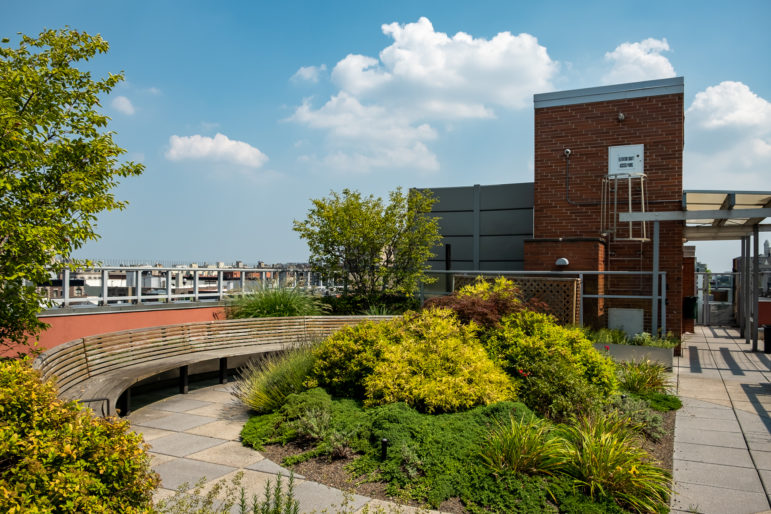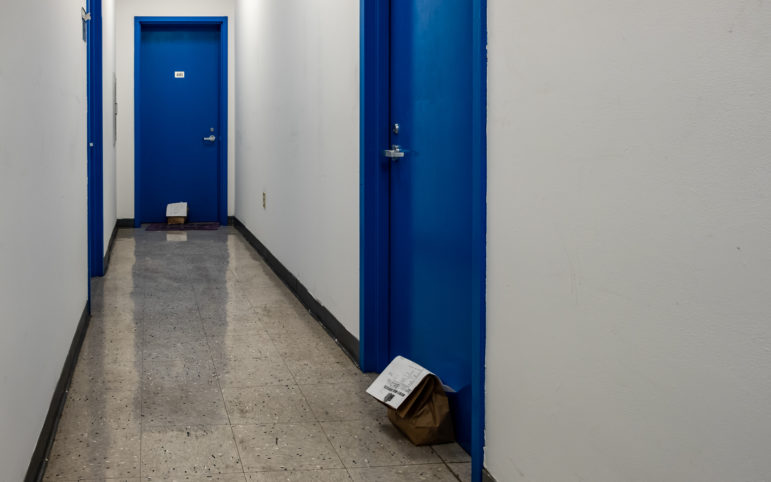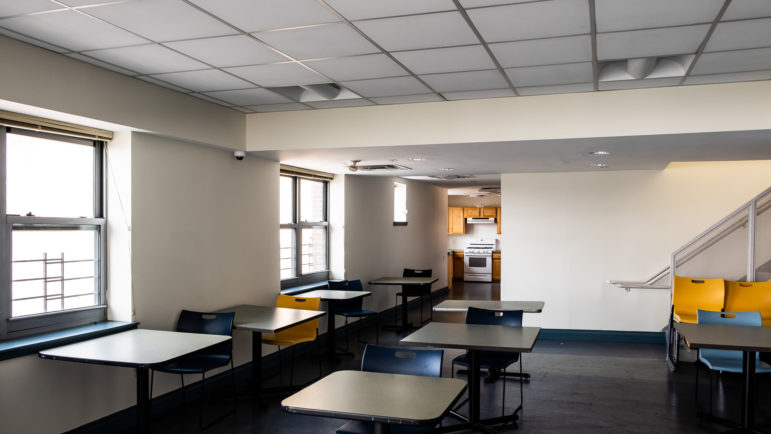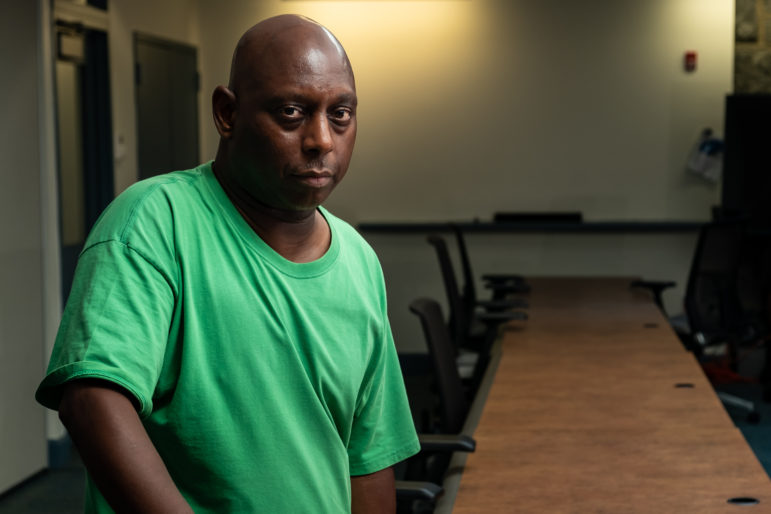As a deepening humanitarian crisis inside the Rikers Island jail complex fuels efforts to release more detainees, a judge’s decision can come down to one key consideration: Do they have a stable address?

Adi Talwar
A dormitory at Fortune Society’s transitional housing program Manhattan.Kandra Clark received an urgent phone call from a man at Rikers Island Tuesday night. A Manhattan judge had agreed to reduce his bail amount, allowing him to afford his release from jail, but only if he demonstrated he had some sort of stable housing.
Clark said she contacted her colleagues at Exodus Transitional Community and managed to secure a room for the man in a Midtown hotel, where her organization provides 24-hour services for homeless New Yorkers released from detention. The judge lowered the man’s bail and he was able to get out—evidence, Clark said, of the institutional disadvantages for New Yorkers sent to Rikers Island from the streets and shelters.
“If they are on Rikers, judges are less inclined to release people if they’re homeless,” said Clark, Exodus’ vice president of policy. But programs like her organization’s city-funded Emergency Reentry Hotels are few and far between, especially for people awaiting trial.
As a deepening humanitarian crisis inside the Rikers Island jail complex fuels efforts to release more detainees, a judge’s decision can come down to one key consideration: Do they have a stable address?
“If they’re just out on the street, especially at arraignment, it’s hard to get a social service program involved at the time and they’re not reachable,” said one Queens judge who asked to remain anonymous in order to discuss their decision-making. “If they have no permanent residency at all, it’s hard.”
“I do believe that a defendant with no real address to return to does become a factor,” said another criminal court judge who agreed to talk on condition of anonymity.
Reporting by the nonprofit Criminal Justice Agency (CJA) seems to bear that out. CJA interviews nearly every person held for arraignment in New York City courts, assesses the likelihood that they will return for future court hearings and creates a scorecard for judges to consider. The latest version of the assessment docks points from a defendant if they have no current address or have lived at their address for fewer than three years.
A 2017 report shared with City Limits showed that 40 percent of defendants identified as street homeless were released on their own recognizance (ROR) at arraignment in 2016, compared to 68 percent of non-street homeless defendants.
At the same time, 70 percent of street homeless New Yorkers who had bail set at arraignment were never released before trial—meaning they pleaded guilty or were convicted by a jury. In contrast, 40 percent of non-street homeless defendants were never released before trial. The rest made bail or were ROR’d after arraignment.
A 2015 CJA report revealed an even more striking disparity: Defendants identified as street homeless were recommended for ROR less than 1 percent of the time, while shelter residents were recommended for ROR 8 percent of the time. In contrast, non-homeless defendants were recommended for ROR—or released without bail—33 percent of the time.
CJA also found that New Yorkers experiencing homelessness were more likely to miss court hearings and less likely to have a surety—someone who could guarantee their bail if they missed court—than the average defendant, two trends likely influencing judges’ decisions. In addition, homeless defendants were more likely to have a history of arrests and convictions, factors intertwined with homelessness that will also contribute to a judge’s thinking at arraignment, said CJA Executive Director Aubrey Fox.
But a lot has changed in the years since those reports, Fox noted. CJA has revamped its assessment tool, recent bail reform measures increased opportunities for people accused of crimes to avoid pretrial detention and local district attorneys decided not to prosecute certain offenses, all leading to fewer jail stays for people charged with misdemeanors and non-violent crimes.
Nevertheless, the Mayor’s Office of Criminal Justice (MOCJ), citing CJA data, says that 5.2 percent of people arrested in New York City are street homeless—up from 4.2 percent in 2016—and notes that they often are not recommended for pre-trial release. There were 2,376 New Yorkers identified as “street homeless” in the city’s most recent annual count; that’s less than 0.0003 percent of the city’s total population.
A third judge who talked to City Limits said the bail reform law—which typically prohibits a judge from setting bail on misdemeanors and nonviolent felonies—has restricted judicial discretion and effectively precluded many defendants from being sent to jail, even if they are homeless. Those who still qualify for bail are typically people accused of violent crimes and would have bail set regardless of their housing status, the judge said.
“Look, the reality is if you’re charged with murder or one of these bail eligible offenses, it doesn’t matter where you live,” they added.
But public defenders and justice reform advocates say it’s more complicated than that. Judges are still setting bail on homeless New Yorkers, especially people living on the streets or in public spaces, in situations where they may treat a person with stable housing differently—often because they conclude that the homeless defendant has fewer community ties and will miss their court dates, said Marie Ndiaye, a supervising attorney in Legal Aid’s Decarceration Project.
“Being unhoused should not influence the court’s decision to set bail,” Ndiaye said. “The current bail law allows judges to set bail only if they find that the person before them is a risk of flight to avoid prosecution, not because they may miss a court date. Being unhoused certainly comes with obstacles that can make appearing in court difficult, but it can’t serve as a proxy for a finding that someone is intentionally fleeing the law. “
City Limits contacted each of New York City’s five district attorneys to see how housing factors into their bail applications. Spokespeople for the Bronx DA Darcel Clark and Manhattan DA Cy Vance cited CJA’s assessment tool, which includes length of time at an address and community connections in determining the likelihood someone will return to jail.
“As we continue to consider releases from Rikers Island, we work in partnership with the defense bar to evaluate defendants who could be released without posing a risk to public safety,” said Clark’s spokesperson Patrice O’Shaughnessy.
Fourteen Bronx defendants are currently being held on bail for non-violent felony offenses, she added. Of those, one is charged with conspiracy to commit murder and six have some sort of state or federal hold forcing them to remain in jail, she said.
Brooklyn DA Eric Gonzalez’s spokesperson Oren Yaniv said prosecutors in his office focus on violence and prior contacts with the criminal justice system. “The defense attorney is the one that typically brings up the defendant’s housing status, community ties etc. and the judge considers all of these factors when deciding on bail,” he said.
Queens DA Melinda Katz and Staten Island DA Michael McMahon did not respond to requests for comment for this story.
Housing to keep the recently released out of NYC shelters
There were 6,079 people locked up in New York City jails Wednesday, including 4,631 held pretrial—most of whom were charged with violent felonies—according to Department of Correction data.
Gov. Kathy Hochul ordered 191 people released who were held on technical violations of their state parole conditions Friday, but the remaining jail population still marks a significant increase from a year ago. There were fewer than 4,000 people held on Rikers during most of April through August 2020, a result of city, state and court actions to move people off the island and out of upstate prisons in order to slow the spread of COVID-19.
Starting in April 2020, the Mayor’s Office of Criminal Justice (MOCJ) began working with Exodus and the organization HousingWorks to quickly establish transitional hotels for people who would become homeless after their release. The three initial sites—two in Queens and one in Manhattan—each featured medical teams, case managers, social workers and employment training on-site.
The calculus is simple: People with their own unit and holistic services are more likely to find jobs, build relationships, receive medical and mental health treatment and overcome the major systemic obstacles to success. People released from Rikers or state prison frequently end up in the city’s crowded shelters, further fueling the homelessness crisis and restricting their individual opportunities. More than half of New York City residents paroled from state prison went straight to Department of Homeless Services shelters in 2017, NY1 reported. They accounted for 1 in 5 new shelter admissions that year.
Yet, there are relatively few transitional housing programs designed to meet the needs of New Yorkers who are homeless after leaving jail and prison—and these do not necessarily lead to permanent housing. There are even fewer options specifically for homeless New Yorkers accused of crimes and awaiting trial.
At the Castle in West Harlem, a stone fortress overlooking Riverside Drive, the Fortune Society operates a transitional housing site for 87 people with some kind of involvement in the justice system, including individuals released directly from state prison.
“They face overwhelming odds if they can’t find a safe place to lay their heads,” said Fortune Society President and CEO JoAnne Page. “They’re excluded and pushed back into homelessness and incarceration.”
Next door, the organization’s 114-unit Castle Gardens housing complex features permanent units for a mix of Fortune Society clients and local community members.
“I was blessed,” said Derek Kelly, a Castle Gardens resident paroled to the Fortune Society in 2012 after 25 years in prison. He lived in the Castle transitional housing program for 18 months before a vacancy in the supportive housing site next door opened, he said.
“This is mine, this is where the peace of mind is going to come from,” said Kelly, 60, during a conversation inside a conference room at Castle Gardens. “If anything goes wrong, it’s like, ‘I’m going home. I’ll see you later.’”
“There’s nothing like having your own,” added Barbara Biscaino, 54, another Castle Gardens resident. She said she was homeless for several years before landing an apartment in Castle Gardens with her daughter, now a college freshman.
DHS has contracted with Fortune to operate 35 additional beds in the Castle complex, said Housing Director Luis Garrastegue. The agency did not respond to a request for comment.
Filling a void
But the Fortune Society only houses a fraction of the justice-involved New Yorkers who are homeless.
MOCJ’s Emergency Reentry Hotels are intended to fill some of that void—replacing the sorts of privately-run “three-quarter home” schemes that once proliferated across the city.
MOCJ officials say the programs have succeeded in ensuring fewer people enter jails or return to prison. The 20.2 percent rearrest rate for people staying in the transitional hotels from March 2020 to July 2021 was less than half the rate of rearrest for all New Yorkers returning from prison (41.2 percent) or jail sentences (42 percent), according to agency data.
The hotels are also used to house a handful of people awaiting trial who would otherwise be on Rikers Island, a city homeless shelter or the streets.
The Queens judge interviewed for this story said transitional housing with on-site social services, like the kind offered by Exodus and HousingWorks, would make them more inclined to order supervised release or to ROR a defendant—especially given the current conditions at Rikers Island, where severe staffing issues have led to inmates missing court dates, medical appointments and going without other basic necessities.
“As a judge, if I hear that they’re at these semi-permanent residences where social services are there to help them, then that would be a factor that I would consider,” the judge said. “It’s crazy what’s going on [at Rikers] and from day to day, we don’t even know in the courthouse who’s going to be delivered and who’s not going to be delivered.”
The transitional hotels now house about 620 people, according to MOCJ statistics. The programs have helped 135 people move into housing, either on their own lease or with friends and family, and more than 150 people living in the hotels are working, Clark said.
The sites encountered intense resistance from local communities concerned about a sudden increase in the number of neighbors accused or convicted of crimes. Residents of Fresh Meadows in Northeast Queens last year protested outside the Wyndham Gardens hotel, where one of the Exodus programs is based.
But in the 107th Precinct, where the hotel is located, index crimes have decreased by more than 21 percent compared to 2020 and by nearly 18 percent compared to 2019, NYPD data shows. Petit larceny, an offense associated with poverty, has decreased by 15.6 percent in the precinct compared to last year. Burglary and misdemeanor assault have ticked up slightly, but remain lower than in 2019.
Earlier this year, MOCJ issued another request for proposals to establish additional transitional housing for people leaving Rikers and state prisons. The units will also go to homeless defendants awaiting trial. The contract documents inform applicants that participants will likely remain in the hotels for an average of six to 12 months, but could be there up to 18 months. Providers are encouraged to find suitable hotels and present the sites as part of their applications.
“The provision of transitional housing is one component of the Mayor’s commitment to continue to safely reduce the jail population,” the proposal reads.
Indeed, the city’s plan to close Rikers Island and build four new jail towers is incumbent on that reduction.
The city must reach a jail population of 3,500 to fit detainees into the four proposed facilities—one in every borough but Staten Island. In 2019, the de Blasio Administration estimated that the jail population would shrink to 3,300 by 2026. That number was predicated on declining crime rates and new state legislation to prevent technical parole violators from being automatically sent to local jails as well as alternative-to-incarceration programs, supervised release and transitional housing, like the kind MOCJ is funding.
“There’s absolutely a need for this,” said HousingWorks President and CEO Charles King. “And I will say that MOCJ understands this need and they’re working very hard to justify these kinds of facilities being funded by the city.”
HousingWorks is bidding to open additional transitional facilities in the coming months, he said. But transitional housing is just a step; the real goal is to establish more permanent apartments for formerly incarcerated New Yorkers who face housing discrimination and other obstacles.
“Look at the percentage of homeless people, particularly street or shelter homeless with behavioral health issues who get caught in this vicious cycle,” King said. “If you put them in permanent supportive housing they are no longer caught in this revolving door and that’s what needs to happen.”















2 thoughts on “As NYC’s Jail Crisis Worsens, Stable Housing Could Be the Difference Between Rikers and Release”
Very interesting read 👣
I was living in this hotel and lived the whole center of this crisis and what they are trying to build to make a difference to the man and woman who needs the support coming from the legal system they house with good services the only problem they have is they use a strategy in the workplace to house only Individuals that ain’t really trying to build a better life to gain Real success they are a business run to keep the company having more and more Individuals to come in In stead of really committing to helping them for the right reasons to be able to move to a successful future I seen and observe a lot of successful men and women who was becoming a greater leader to they company get kick out and seen them leave more pedophiles. And individuals with substance abuse use in the Hotel they hire staffing that is living in a shelter or transitioning to your own life to get better it’s a motive they use they don’t help